


This has to do with page margins-how to do them right and how not to do them wrong. Today, I want to look at one of the most common of these mistakes, and show you easy ways to avoid it. For instance, last year I was judging the annual book competition for a local publishing group, and I found formatting and book construction mistakes in many of the books produced by amateur publishers. I talk to a lot of authors and look at hundreds of self-published books, and the ones that are problematic jump out at me.

Longstanding habits of readers and accepted trade practices have come to dictate that we follow these formatting guides unless we have a pretty good reason not to. It’s important to stay within formatting conventions because printed books have existed for a long while. When authors decide to format their own books, they don’t always make the best choices.


 0 kommentar(er)
0 kommentar(er)
